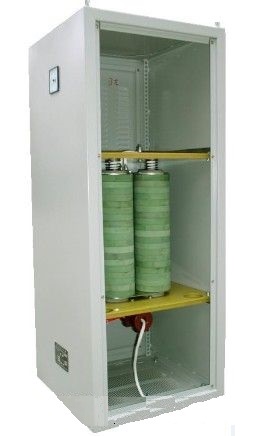


Product Usage
In the 6-35kV AC power grid, the neutral point of the power grid may adopt grounding methods such as ungrounded, arc suppression coil grounding, high resistance grounding, medium resistance grounding, and low resistance grounding. In cable powered systems, the grounding capacitance is relatively large. When the current exceeds the specified value, there is a possibility of arc grounding overvoltage. The purpose of using neutral point resistance grounding method is to inject resistive current into the fault point, making the grounding fault current exhibit resistance capacitance properties, reducing the phase difference angle with voltage, reducing the reignition rate of the fault point current after zero crossing and arc extinguishing, and limiting the overvoltage to 2.6 times the phase voltage. Simultaneously improving the sensitivity of relay protection to act on tripping, thereby effectively protecting the normal operation of the system.
ZW-ZTF type non-metallic resistors are suitable for medium and small resistance grounding methods. It is installed on the neutral point of transformers or generators in 6-35kV AC power grids, such as power plant systems, substation power supply systems, and industrial and mining enterprise distribution systems, to achieve the operation mode of using resistance grounding for the neutral point.
Product features
1. Using special non-metallic resistance materials with small volume
The existing grounding resistors are composed of nickel chromium alloy strips, copper alloy strips, or stainless steel sheets stacked together. Due to its low resistivity, this type of resistor has many consumables, large volume, high price, and a small resistance range.
The ZW-ZTF type non-metallic resistor resistor material is made by sintering various non-metallic materials such as carbon and aluminum oxide. Due to its resistivity ranging from 1.87 to 2.67 x 106 µ Ω · m, which is much higher than the resistivity of any metal material (usually 1-2 µ Ω · m), the structure of the resistor is very compact and compact in size.
2 trace negative temperature characteristics to improve protection sensitivity
The conductive coal of ZW-ZTF type non-metallic resistor material is mainly carbon, relying on many parallel and interwoven carbon chains to conduct electricity. At the same time, the conductivity of a resistor is related to the temperature of the resistor substrate. The higher the substrate temperature, the more molecular motion intensifies, and the conductivity is enhanced. When the temperature rises, the molecular movement of any substance becomes more active, and its resistance value will decrease. ZW-ZTF type non-metallic resistors, like metal resistors, have a negative temperature coefficient of ≤ -0.045% ℃, indicating that during the operation of the resistor, as the temperature increases, the resistance value slightly decreases. This small decrease in resistance value increases the sensitivity of relay protection action, which is beneficial but harmless.
3. Wide resistance range and wide adaptability
The resistance used in the ZW-ZTF type non-metallic resistor is a ring-shaped chip resistor. And through a series parallel structure, resistors with different resistance values and currents between 6 Ω and 1000 Ω are made to meet the needs of users, adapt to different places, and achieve their functions and effects.
4. Large heat capacity, high temperature resistance, low temperature rise
The resistance material of ZW-ZTF type non-metallic resistors is carbon. The melting point of carbon element is greater than 3500 ℃. The melting point of the resistor chip in the resistor is greater than 3000 ℃, the thermal capacity is greater than 1000J/cm3, the current range is 4A-600A, and the current passing time is much longer than 10S. So, ZW-ZTF type non-metallic resistors have high temperature resistance